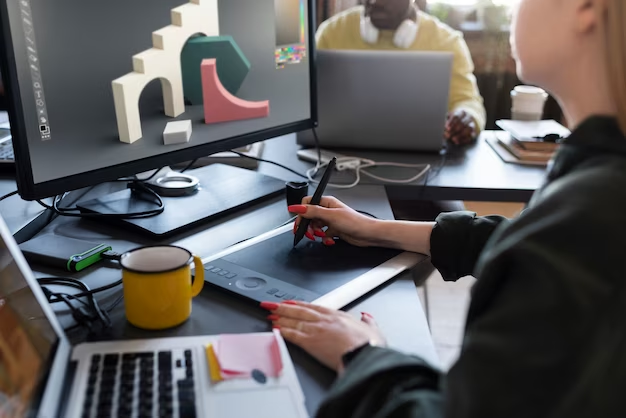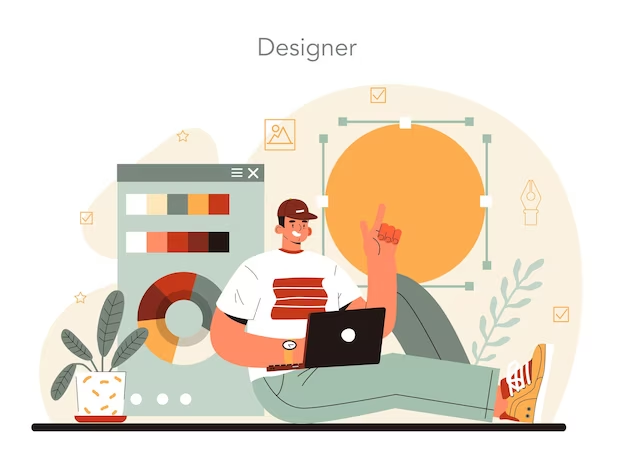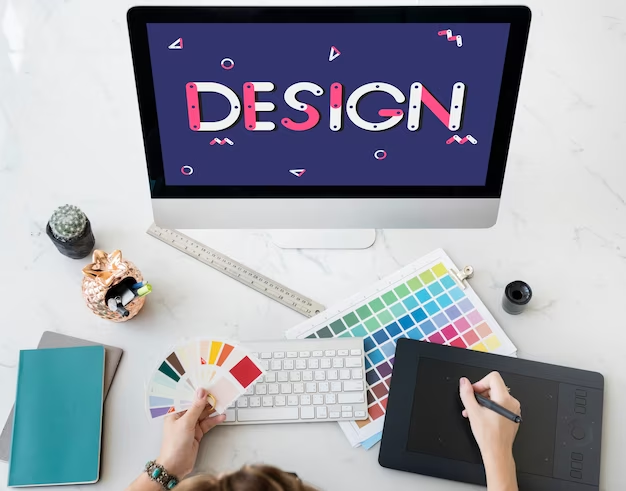Graphic Design serves as a medium for visual communication, conveying notions and products effectively. The process involves a designer employing a variety of elements such as typography, hues, drawings, and images to articulate thoughts. The application of graphic design amplifies the prominence and persuasive power of the content. It’s not just a daily life phenomenon but also a crucial aspect of business operations. The significance of graphic design is undeniable in society and its evolving trends, as reflected through historical and architectural lenses.
Fact One | The Earning Capacity of Graphic Designers is Substantial.
The average income of an accomplished graphic designer lies within the range of $32.4K to $78.2K annually. However, the ceiling for such earnings can be considerably higher, influenced by factors such as geographic location, level of expertise, and accumulated experience. Big enterprises are known to compensate graphic designers handsomely for their logo and brochure creations. The need for originality drives these companies and brands to outsource their creative needs, as they may have the financial means but are deficient in the artistic aspect. This is the juncture where premier graphic design expertise becomes invaluable.
For a company, its logo carries significant weight in establishing its corporate persona. Often, it is more economically viable to commission a designer than to have a full-time designer on their payroll. Given the vital role a logo plays in a company’s brand imaging, it is understandable why they would invest a sizeable amount into stellar design work. Graphic designers can receive commissions for an array of assignments, including leaflets, business cards, flyers, and brochures, often making thousands of dollars off a single design project.

Fact Two | Graphic Designers Do Not Need A Design Degree to be Successful.
It’s not a necessity for a graphic designer to hold a formal degree in design for achieving success. Their portfolio and the mastery of design techniques can land them job opportunities. The surge in the preference for digital learning platforms like Udemy, Lynda, or Unacademy has made the process of learning graphic design simpler and more reachable. With a combination of dedication, regular practice, and patience, along with a variety of resources (online lessons, concise courses, classic literature), any enthusiastic learner can enter this field.
If you’re aiming to enhance your understanding, there are books like How to be a Graphic Designer, Without Losing Your Soul by Adrian Shaughnessy. It uses a rich array of experiences to offer a guidebook that assists graphic designers in steering their careers. The updated and expanded edition brings in completely fresh chapters that focus on professional capabilities, the process of creation, and global tendencies, encompassing topics like environmental considerations, ethical practices, and the burgeoning digital culture.
Fact Three | Graphic Designers Will Experience an Increase in Demand Over the Next Decade.
Graphic designers are now playing a critical role in digital commerce, as the Internet becomes an increasingly important platform for businesses of all sizes. The anticipated 13% increase in demand for graphic designers by 2020, as predicted by the Bureau of Labor Statistics, illustrates the potential that lies within this profession.
Moreover, the economic performance of the graphic design industry is equally promising. In 2019, it contributed a substantial $15 billion to the economy and grew at a rate of 3.5% annually. Even more impressively, it’s expected to further expand at a rate of 2.7%, eventually becoming a $14.8 billion-dollar-strong industry.
The increase in the number of graphic and design businesses in the US, reaching 16,823 by June 2019, is a clear testament to the industry’s vibrancy. The report from the Design Management Institute, indicating that design-driven businesses have consistently outperformed the S&P 500 by an astonishing 219% from 2004 to 2014, further underscores the value of design.
From a business perspective, it’s noteworthy to mention the correlation between creativity and market share. Companies that encourage creativity have been found to achieve 1.5 times greater market share. Additionally, the perception of graphic design’s importance is rising among small businesses, with 67% of them expecting it to become increasingly crucial to their success over the next five years.
All these factors point towards an exciting future for the graphic design industry. It’s an opportune moment for anyone considering a career in this creative, dynamic, and rewarding field.
Fact Four | Marketing Ideas are Visualized by Graphic Designers.
Each product and service you’ve chosen to procure has, at one juncture, enticed your purchase decision using visual design in marketing. Everything ranging from the labels that adorn food items to the billboard publicity of your insurance provider has employed the skills of graphic designers in their marketing initiatives.
Graphic designers enhance marketing efforts on every platform and are integral to the establishment of a professional brand identity. The essence of graphic design is its persuasive power and the reinforcement of a robust business image. Impressions of a brand, logo, or design form in the mind within mere seconds.

Fact Five | The Role of Graphic Designers in Forming Cultural Movements
Over the last hundred years, graphic designers have been instrumental in the creation of many key visual moments in culture. For instance, Art Nouveau, a primarily decorative cultural wave that swept across Europe and America, is an example. This style, known for its natural, irregular lines over rigid, consistent shapes, influenced a range of areas from architecture and interior design to jewelry, as well as poster design and illustration.
The Art Nouveau movement was championed by people like Charles Rennie Mackintosh, a Scottish architect and designer, Alphonse Mucha, a Czech graphic artist, and Antonio Gaudí, a famed Spanish architect and sculptor. Many of Mucha’s beautiful works, several being advertising assignments, masterfully mixed Art Nouveau’s fluid, natural lines and motifs with evocative portraits of women.
Some of the movements that occurred include:
- Cubism (1900-1930) – This groundbreaking art movement of the 20th century, led by artists like Pablo Picasso and Georges Braque, brought a seismic shift to European painting and sculpture. In Cubist pieces, subjects are dissected, scrutinized, and then put back together in an abstract style;
- Dada (1900-1930) – This movement was centered around the visual arts, literature, poetry, art declarations, art theory, theater, and of course, graphic design. It expressed its anti-war stance by challenging established art norms through the creation of anti-art pieces in the cultural sphere.
Fact Six | Graphic Designers Have Many Talents.
The repertoire of graphic designers has expanded to include numerous new abilities in order to fuel their artistry. Previously, the development of media content for a corporation revolved around articulating the business’s functions as effectively as possible. Although this aspect still plays a key role in modern graphic design, the field also encompasses a variety of fresh ideas. To meet the diverse requirements of companies today, graphic designers are often required to be versatile, which might mean learning coding, mastering copywriting, and honing traditional graphic design competencies like drawing and Adobe CC.
Fact Seven | Graphic Designers Have Been on the Earth Circa the 1400s.
Tracing its roots back to the civilizations of ancient Egypt, Greece, and China, the evolution of graphic design has witnessed numerous transformations. As the 15th century dawned, craftsmen such as compositors and typesetters began experimenting with composition and typography, leading to significant advances in book production and printing.
The dawn of the 19th century heralded a new era in graphic design, fueled by leaps in technology. This led to the emergence of graphic design as a dedicated profession, driven by the increasing demand for specialization in response to commercial opportunities and technological progress intertwined with industrialization.
By the time the 19th century came to a close, graphic design had evolved into a form of communication. The term ‘graphic design’ was first introduced to describe this growing domain of visual communication by typographer William A. Dwiggins in 1922. The 20th century saw additional technological advancements, paving the way for the maturation of graphic design as a recognized profession.
Modern graphic designers began to venture into uncharted territories, such as creating magazine covers, thereby introducing a fresh aesthetic by integrating art. As the new millennium began in 2001, graphic design had become a globally acknowledged industry. Today, graphic designers are entrusted with crafting compelling and conversion-oriented artwork for a variety of mediums, including advertisements, magazines, packaging, websites, and more.

Fact Eight | Graphic Designers Can Work for Themselves, Anywhere.
One of the advantages of being a graphic designer is the opportunity to operate independently. If you’re not seeking traditional employment but possess the necessary skills and tools to craft compelling visuals, it might be time to consider searching for your own projects.
As design software becomes increasingly accessible on portable devices such as laptops and smartphones, it’s become simpler for graphic designers to operate from any location worldwide. This shift has not only allowed designers more freedom but also opened doors for organizations to tap into a global pool of talent without the need to employ in-house.
This evolution has resulted in a surge of freelance designers, each operating from their unique creative spaces around the globe. Many businesses have begun to appreciate the cost-effectiveness of this model. Leveraging online job platforms, designers can swiftly and efficiently find projects that suit their skills. If you’re looking to expand your portfolio, promoting yourself as a freelance designer could be a viable option.
Fact Nine | The Role of Graphic Designers in Enhancing Global Accessibility
Countless individuals globally live with some form of disability or impairment, ranging from visual to auditory to physical. The importance of accessibility-oriented design in delivering information to the broadest audience cannot be overstated, and today’s technology makes this significantly more achievable.
Emphasizing accessibility in design is crucial due to a potential scarcity of digital content specifically created for those with disabilities or impairments. Neglecting to provide for this demographic restricts universal access to valuable or enjoyable content. Graphic designers, therefore, stand to become key facilitators in fostering a more inclusive society.

Fact Ten | Graphic Designers Aid in Making the Globe More Eco-conscious
As pioneers in their field, graphic designers carry the duty to reduce their environmental impact by adopting more enlightened, less harmful, and less wasteful methodologies regarding the use of materials and energy. Imparting knowledge about sustainable designing to future designers is a critical move towards a greener globe.
It’s crucial for designers to pay heed to their choice of materials—the manufacture of paper attributes roughly 40 per cent of the cause for the world’s industrial-scale deforestation. The creation of fresh paper is damaging and demands trees, energy, and water. As for substitutes, PCR has emerged as a replacement for paper. Additionally, there are various other alternatives to paper that are becoming accessible.
Fact Eleven | Machines Cannot Substitute Human Graphic Designers.
Graphic design relies on human-derived intelligence, instincts, and creativity to cater to changing trends and preferences, which are set by us. While I consider it essential to embrace and train in contemporary technology to support designers in executing their tasks, I assert that our design perception is a skill that machines are unable to duplicate.
Ever encountered a tune or witnessed a piece of art solely crafted by artificial intelligence? It’s peculiar, isn’t it? Despite the application of all appropriate mathematical fundamentals, machines fail to grasp what genuinely appeals to human senses because we are beings with subjective perceptions. We determine what’s tasteful.
Fact Twelve | Graphic Design Professionals Persist as Pioneers.
The cornerstone of graphic design mentality is the inception of creations we didn’t realize we were lacking. This propels individuals to contemplate potentialities rather than just enhancing pre-existing constructs.
In the realm of graphic design, we typically employ visual components to articulate the designer’s thoughts and schematics, using text and graphics to communicate our information to customers so they can grasp our perspective and tactics. Absence of pioneering thought equates to the absence of implied meaning. There’s the crux – graphic design professionals embody more than what’s perceptible at first glance. Design assumes a colossal role in our enterprises and everyday experiences.
Conclusion
In summary, the role of graphic designers extends beyond simple aesthetics. These 12 facts we’ve explored provide an insightful glimpse into the depth and breadth of their work. Remember, every time you interact with a well-designed product or service, a graphic designer’s work has likely played a significant role in that experience.





